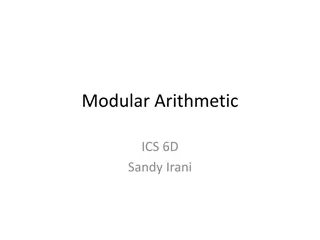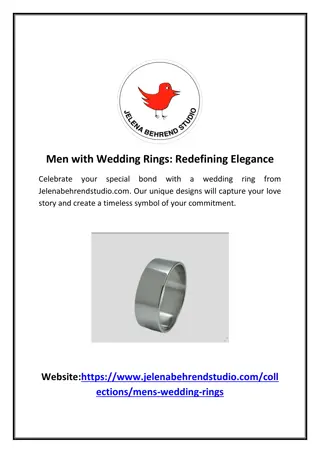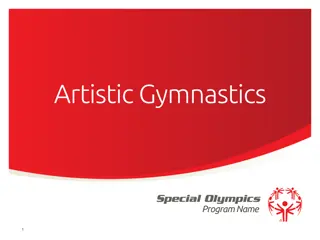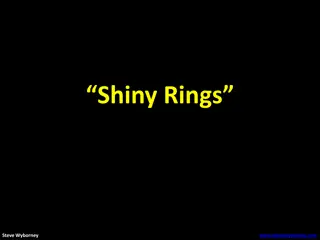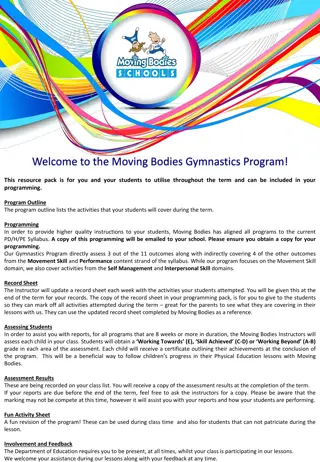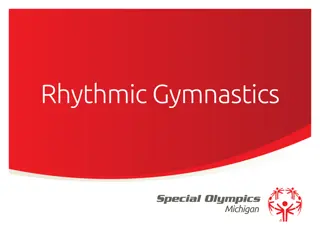Gymnastics Rings Skills Guide
Learn the intricate techniques of perfect swing, backup rise, shoulder stand, handstand, hanging L-sit, and flyaway on gymnastics rings. Master the key elements for each skill to improve your gymnastics performance.
Download Presentation

Please find below an Image/Link to download the presentation.
The content on the website is provided AS IS for your information and personal use only. It may not be sold, licensed, or shared on other websites without obtaining consent from the author.If you encounter any issues during the download, it is possible that the publisher has removed the file from their server.
You are allowed to download the files provided on this website for personal or commercial use, subject to the condition that they are used lawfully. All files are the property of their respective owners.
The content on the website is provided AS IS for your information and personal use only. It may not be sold, licensed, or shared on other websites without obtaining consent from the author.
E N D
Presentation Transcript
Perfect Swing A good swing on rings takes a much longer time to develop than high bar. The gymnast must keep tension on the rings at all times. On the forward swing the gymnast should try to turn over quickly then push the rings back and extend as much as possible. The rings should be turned in so that the gymnasts palms are facing back. On the rearward (directed towards the back) swing the gymnast should drive their heels aggressively keeping their shoulders and chest pressed down as they rise. The rings should be turned outward, and pressure must be kept.
Backup rise Heel drive is the key. Most gymnasts will want to lift their shoulders early to get to support. It is very important that the heels lead during the upwards swing, not only for the backup rise, but for just about every rear swinging skill. After the heels drive towards the ceiling the gymnast should think about pulling the rings well underneath them while continuing to drive their heels. The gymnast should focus on controlling the support in the position and lowering to a straight support slowly.
Shoulder Stand The shoulder stand is very similar to a press handstand. The main difference is that the end of the skill, the body is positioned in vertical with arms bent. To perform this skill, the gymnast should start in support or L-sit and raise their buttocks slowly. They should compress their body into a piked position. When the upper body reaches vertical, the gymnast should lift their legs to the vertical position as well. At the same time, the gymnast should slowly bend their arms until they reach the shoulder stand position. Their head should be slightly open and the gymnast should watch the floor. The gymnast should not touch the cables with any part of their body or upper arms. They should hold this skill in a straight, slightly hollow position.
Handstand A handstand on rings is typically more difficult than other variations. This is because the rings themselves are not static, which means that the gymnast needs to have basic strength requirements in order to balance properly. The arms should be parallel at the width of the shoulders. Also, they shouldn t touch the cables. The arms and legs should be completely straight. The shoulder angle should be completely extended. During the handstand, the butt and core should be tight, and the head should be in a neutral position with the eyes watching the hands.
Hanging L-sit From a straight arm hang, the gymnast lifts their tight legs to a hanging L-sit. The legs are at horizontal. The rings are turned out, the wrists should be visible from the side. The shoulders are completely extended. The head is in the middle position. The back is straight.
Flyaway The skill starts from a front swing. From a hang, the gymnast should start bending the legs and pulling up with the arms. The move should be strong and powerful. Bent arms give acceleration to the backflip. The pulling up of the arms gives height to the flip. When the bent knees reach the cables, the athlete leaves the rings and continues the rotation of the body backward. Before landing, the body opens fully and extends the arms
UNEVEN BARS GRIPS Standard Grip Put your arms up with your palms facing forward. This grip is used for most casts to handstand, giants, kips and many other skills. Reverse Grip Put your arms up with your palms facing forward, then turn your hands inward 180 degrees (turn your left hand right and your right hand left) so your thumbs are on the outside. This grip is used for front giants, certain forward-moving release moves and forward flipping dismounts.
Eagle Grip Put your arms up with your palms facing forward then turn your hands outward 180 degrees (turn your left hand left and your right hand right) so your thumbs are on the outside. If you feel really uncomfortable or can t even put your arms and hands into this position, you re doing it right. This grip is very difficult and used for many of the same skills as reverse grip. L-Grip For L-Grip, one hand will be in the reverse grip position and the other will be in eagle grip position. This grip is awkward to use and is very difficult. It is used for many of the same skills as reverse and eagle grip.
Dimensions Height: High bar: 250 centimetres (8.2 ft) Low bar: 170 centimetres (5.6 ft) Diameter of bar: 4 centimetres (1.6 in) Length of the bars: 240 centimetres (7.9 ft) Diagonal distance between the two bars: varies, 130 centimetres (4.3 ft) 190 centimetres (6.2 ft) (adjustable)
Hecht Mount In a hechtmount, the gymnast runs up to the low bar, jumps onto a springboard, pushes off the low bar as she flies over the bar and grabs the high bar, performing a kip until she is in a front support on the bar.
Back Hip Back Hip Circle Circle The gymnast should begin in front support. They should kick back with a regular cast with their hips away from the bar. When their hips return to the bar, they should lean back with their shoulders, creating speed to execute a circle around the bar. The body should be in a hollow position, with their hips turning around the bar. Their elbows should be tight, and their buttocks squeezed. As they execute the skill they should shift their wrists around the bar as they rotate. They should finish the skill in front support. The entire skill should be performed with a neutral head position.
Flyaway In the downswing near the lower vertical position. The body should be in a hollow position. It s extremely important for the shoulder angle to be open and the head in a neutral position. This should eliminate the risk of performing the flyaway closer to the bar. Usually, the dismount is performed during the changing the bars from low to high when the body reaches its velocity. In the upward swing, the body should be in a hollow position with the shoulders and arms fully extended with the head in the middle position. During the flight, the body continues to rotate in a hollow position. Before landing, the gymnast should extend to a stretched position and extend their arms. Slightly fold the knees to absorb the shock.
SCORING Bar routines are scored based on the difficulty of the routine and the execution. Deductions are taken on the execution of the routine for poor form (bent body, arms and legs) and the rhythm and dynamics of the routine are evaluated. If the gymnast falls during her bar routine, she has 30 seconds to get back up and continue her routine. A deduction from her score will be taken for the fall.
HORIZONTAL BAR (SWING) The essential skill on high bar is the swing. Almost every skill on this apparatus consists of a front or backswing. The skill starts at the highest point of the backswing. The gymnast should be in a hollow body position with their head neutral. At the bottom of the swing the gymnast should arch slightly, making a whip. They should then return to the hollow position in the front swing.
Back Hip Circle Back Hip Circle The gymnast should begin in front support. They should kick back with a regular cast with their hips away from the bar. When their hips return to the bar, they should lean back with their shoulders, creating speed to execute a circle around the bar. The body should be in a hollow position, with their hips turning around the bar. Their elbows should be tight, and their buttocks squeezed. As they execute the skill they should shift their wrists around the bar as they rotate. They should finish the skill in front support.
Kip to Support Kip to Support It s two main uses are to start a routine and to connect skills. The skill starts from standing or from a front swing. The up swing should finish around 45 degrees under horizontal. The body is completely extended. The gymnast lifts his/her legs towards the rail. The move continues backward in a piked position, the toes should touch or be very close to the bar. In the up swing the body gradually transforms from a piked position to a hollow. The gymnast pushes the bar towards the hips with tight arms. Legs are following the rail from the toes to the hips. Before reaching support, the gymnast shifts her/his wrists and lean shoulders forward. The skill finishes in support.
Stalder It could start from a handstand, before handstand with early piking, or after handstand with a shoulder angle. The classical stalder starts from a handstand with an opening and pike from the legs. Until horizontal, the gymnast should keep the shoulder angle extended. At the same time, they should gradually pike the body into a straddle (pancake) from the top vertical to the horizontal in order to accelerate the speed and the bail. From the horizontal, the legs should be infilled behind the bar and at the same time, the shoulder angle increases until to its maximum through the bottom vertical. The ideal position in the lower vertical is to have the body in horizontal and the legs in straddle behind the shoulders and the head. In order to do this skill, the gymnast should be very flexible. From the bottom continues the reverse move. The shoulder angle extends in a straddled pike. In the higher vertical, the gymnast raises the legs and finishes the skill in a handstand.
Flyaway In the downswing near the lower vertical position. The body should be in a hollow position. It s extremely important for the shoulder angle to be open and the head in a neutral position. This should eliminate the risk of performing the flyaway closer to the bar. In the upward swing, the body should be in a hollow position with the shoulders and arms fully extended with the head in the middle position. During the flight, the body continues to rotate in a hollow position. Before landing, the gymnast should extend to a stretched position and extend their arms. Slightly fold the knees to absorb the shock.
Pommel Horse Swings Straddle legs sideways wide throughout the swing. Upper body stays upright throughout the swing. Hips are in, do not support hollow body position. Straight body is moving in front plane without any deviations. When gymnast lifts left leg, left arm pushes left pommel and center of gravity moves into right pommel/arm. Vice versa with right leg lift.
Scissors Cut the left leg forward to stride support and continue stride support swings. The right-hand pushes the analogical pommel, and the body transfers onto the left pommel. At the highest point of the swing, the hips move forward in the center of the horse and the legs switch their position. The left leg cuts under and returns to front support, the right leg cuts forward to stride support. The scissor with the right leg is done in the opposite. The coach should emphasize on several topics: Transfer the body from one pommel to another with hops. The swings are exactly sideways along the longitude of the horse. During the cuts and mixed leg swings, the hips should be directed in the center of the horse. The switch of the legs initiates from the hips. The legs are wide open.
Circles on Mushroom The circle on mushroom is a basic drill for learning circles on pommel horse or beam. To do this drill, the gymnast must first place their hands on the horizontal line across the mushroom. During the performance the athlete should not change this position of their hands. They should start in front support with their shoulders leaned slightly forward. They should face their hands forward with their fingers spread for better support. Next, they should step to the side opposite of their desired circle direction. The entire circle should be performed with a completely straight body. There are several universal points that the gymnast should follow: The arms and legs should remain tight, no exceptions; In the third quarter, the gymnast should switch the support hand and start pushing down on the mushroom in the opposite direction from the circle trajectory. The leading part of the body during this phase are the heels; Then the gymnast should put their first hand back down on the mushroom and finish in front support. In order to assure continuity, the body should not touch the mushroom, and the shoulders should lean forward; In the fourth quarter the gymnast put the first hand on the mushroom and finishes in front support. In order to assure continuity, the body should not touch the mushroom and the shoulder should lean forward. During the execution of the skill, the shoulders lean in the opposite direction from the legs
DISMOUNT Wende Handstand




![[PDF⚡READ❤ONLINE] Neptune: The Planet, Rings, and Satellites](/thumb/21522/pdf-read-online-neptune-the-planet-rings-and-satellites.jpg)

